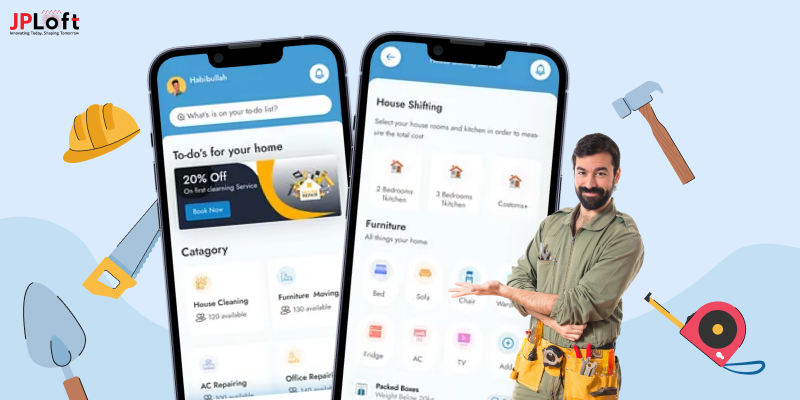Balancing home chores with a busy work life can be difficult. Handyman apps offer a convenient solution connecting users with skilled professionals for jobs like plumbing, electrical fixes, and home upkeep.
The global handyman service market was valued at nearly $448.89 million in 2024 and is expected to reach $1,579.14 million by 2033, growing at a CAGR of 16.5%.
This significant growth has caught the interest of businesses and service providers eager to tap into this growing industry, especially concerning the cost to develop a handyman app.
On average, the estimated development cost of a handyman app ranges between $15,000 and $50,000, based on various factors. The price can go beyond for the advanced version.
In this blog, we'll explore the success of developing a handyman app in 2025, break down the related costs, discuss key factors affecting these expenses, and provide strategies to reduce development costs while maximizing returns.
Why Developing a Handyman App is Profitable in 2025?
Life is getting busier, and people are looking for quick, hassle-free answers for their home care needs.
If it's fixing a leaking tap, putting a ceiling fan, or repairing furniture, nobody wants to go through the trouble of finding a reliable handyman manually.
That’s where handyman apps or home service apps come in! They make it super easy for users to book professional help with just a few taps, making a win-win situation for both buyers and service providers.
1. Booming Market Demand
The on-demand service business has been growing quickly, and handyman services are no exception. With more people choosing online platforms for home services, the market for handyman apps is growing fast.
According to industry reports, the handyman service market is expected to grow greatly in the coming years, making it the perfect time to build a handyman app and tap into this lucrative industry.
2. High Earning Potential
A well-developed handyman app can produce income in multiple ways.
You can charge a fee for each booking, offer subscription plans for service providers, or even allow ads and highlighted listings.
Since people will always need home fixes and upkeep, demand for these services will stay steady, ensuring a stable income stream for app users.
3. Cost-Efficient Business Model
Compared to starting up a physical handyman or home service business, the cost of home service app development is relatively cheaper.
There’s no need to rent office space or hire a big staff. By simply investing in app development and marketing, you can run a successful on-demand handyman business with low running costs.
4. Scalability and Growth
One of the biggest benefits of making a handyman app is its scalability. You can start by targeting a local market and spread to multiple towns or even countries.
As your user base grows, you can offer advanced features, partner with more service providers, and increase income without major additional investment.
With a growing market, steady demand, and multiple revenue opportunities, investing in the handyman niche is a smart move in 2025.
In the next section, we’ll break down how much does it cost to build a handyman app and later we will discuss what factors influence it.
How Much It Costs to Create a Successful Handyman App?
When planning to enter the handyman service industry, one of the first questions that comes to mind is, "How much does it cost to develop a handyman app?" The answer depends on several factors, including the app’s complexity, features, and the development team you hire.
On average, the cost to create a handyman app in 2025 ranges between $15,000 and $50,000+. A simple app with basic features like service listings, booking options, and payment integration falls on the lower end of the spectrum.
However, if you want an advanced app with real-time tracking, AI-based recommendations, and in-app chat support, the cost to develop a handyman app can go beyond $50,000.
The cost to build a handyman app in 2025 also depends on the development team. Hiring an experienced on-demand app development company ensures a high-quality app, but it comes at a higher cost.
Freelancers or smaller agencies might offer budget-friendly options, but they may lack the expertise needed for long-term success.
The app development is an investment, and knowing the estimated cost helps in better budgeting.
Let’s move on to the next section to dive deeper into the key factors influencing the cost of handyman app development to give you a clearer picture.
Key Factors Influencing the Cost to Build a Handyman App
The handyman app development cost depends on several factors, including the app's features, development team, and design complexity.
Let’s break down the key elements that affect the cost to build a handyman app so you can plan your budget wisely.
1] App Features and Functionality
The more advanced features you add, the higher the cost to make a handyman app. Basic features like user registration, service listings, booking, and payments are essential.
However, if you include premium features such as real-time tracking, AI-based recommendations, and multi-payment integration, cost will increase.
A simple handyman app may cost around $15,000, while an advanced app with complex functionalities can exceed $50,000.
|
Feature |
Description |
Average Cost ($) |
|
User Registration & Login |
Allows users to sign up and log in via email, phone, or social media. |
$1,500 – $3,000 |
|
Service Listings |
Displays available handyman services with descriptions and pricing. |
$2,000 – $4,000 |
|
Search & Filters |
Helps users find specific services based on category, price, or ratings. |
$1,500 – $3,000 |
|
Booking & Scheduling |
Enables users to book a handyman at their preferred date and time. |
$3,000 – $6,000 |
|
In-App Chat & Calls |
Allows direct communication between users and service providers. |
$2,500 – $5,000 |
|
Real-Time Tracking |
Lets users track the handyman’s arrival and service progress. |
$3,500 – $7,000 |
|
Payment Integration |
Supports multiple payment options like credit cards, wallets, and UPI. |
$3,000 – $6,500 |
|
Review & Rating System |
Enables users to rate and review service providers after completion. |
$2,000 – $4,000 |
|
Push Notifications |
Sends alerts for booking confirmations, updates, and offers. |
$1,500 – $3,500 |
|
Admin Dashboard |
Allows app owners to manage users, services, and payments. |
$4,000 – $8,000 |
2] App Design and User Experience
A well-designed app attracts more users and keeps them engaged. If you want a simple design, the cost to build a handyman app will be lower.
However, for a high-end, visually appealing app with smooth animations, easy navigation, and an intuitive interface, the cost will rise. Investing in a great UI/UX design can make your app stand out and improve user retention.
|
UI/UX Element |
Description |
Average Cost ($) |
|
Wireframing & Prototyping |
Creates the initial app layout and structure before full design. |
$1,500 – $3,500 |
|
Visual Design & Branding |
Includes color schemes, typography, and logo integration. |
$2,000 – $5,000 |
|
User Interface (UI) Design |
Develops interactive and appealing screens for a smooth experience. |
$3,000 – $6,000 |
|
User Experience (UX) Optimization |
Enhances navigation and ease of use for better engagement. |
$2,500 – $5,500 |
|
Animations & Micro-Interactions |
Adds visual effects for a dynamic user experience. |
$2,000 – $4,500 |
3] Development Team and Location
The cost to build a handyman app in 2025 also depends on who you hire. A development agency from the USA or UK may charge $100-$150 per hour, while developers from India or Eastern Europe may cost around $30-$50 per hour.
If you choose freelancers, the cost might be lower, but the quality and long-term support may not be as reliable. Hiring dedicated developers ensures a well-built, scalable app, so choosing wisely is crucial.
|
Country |
Hourly Development Rate ($/hr) |
Average Cost ($) |
|
United States |
$100 – $150 |
$50,000 – $100,000+ |
|
United Kingdom |
$80 – $130 |
$40,000 – $90,000 |
|
Australia |
$70 – $120 |
$35,000 – $80,000 |
|
Eastern Europe (Ukraine, Poland, etc.) |
$40 – $80 |
$20,000 – $50,000 |
|
India |
$30 – $50 |
$15,000 – $40,000 |
4] Platform Choice (Android, iOS, or Both)
If you’re building a handyman app for just one platform (either Android or iOS), the cost to create a handyman app will be lower.
However, developing a cross-platform app that works on both Android and iOS increases the estimated development cost of a handyman app. A native app offers better performance but costs more, while hybrid apps are cost-effective but may have performance limitations.
|
Platform |
Description |
Estimated Cost ($) |
|
Android App |
Develops the handyman app for Android users only. |
$15,000 – $35,000 |
|
iOS App |
Creates a dedicated iOS app for Apple devices. |
$15,000 – $40,000 |
|
Cross-Platform (Flutter/React Native) |
A single app for both Android and iOS, saving costs. |
$20,000 – $45,000 |
|
Progressive Web App (PWA) |
A lightweight web-based app that works on all devices. |
$10,000 – $30,000 |
|
Native App (Both Platforms) |
Separate apps for Android and iOS with the best performance. |
$30,000 – $60,000 |
5] Backend Infrastructure
A correct mobile tech stack ensures smooth performance, but it also impacts the app development cost. The backend manages databases, user authentication, booking systems, and communication between different components of the app.
Choosing scalable cloud solutions like AWS, Firebase, or Microsoft Azure can improve performance but may add to the cost to build a handyman app. A well-built backend guarantees security, fast response times, and a seamless user experience.
|
Backend Component |
Description |
Estimated Cost ($) |
|
Database Management |
Stores user data, bookings, and transactions securely. |
$3,000 – $7,000 |
|
Cloud Hosting |
Ensures app scalability and fast performance. |
$2,000 – $6,000 |
|
API Development & Integration |
Connects frontend with backend services and third-party tools. |
$4,000 – $10,000 |
|
Admin Panel Development |
Enables app owners to manage users, services, and payments. |
$5,000 – $12,000 |
|
Security & Compliance |
Implements encryption, authentication, and fraud detection. |
$3,000 – $8,000 |
6] Third-Party Integrations
Features like cloud storage, push notifications, real-time updates, and third-party integrations (such as Google Maps and payment gateways) can raise the handyman app development cost.
Using pre-built APIs for payments, messaging , or location tracking can save money, but for a more customized solution, expect a higher cost to develop a handyman app in 2025.
The more integrations required, the more expensive the mobile app development process becomes.
|
Integration |
Description |
Estimated Cost ($) |
|
Payment Gateway (Stripe, PayPal, etc.) |
Enables secure online payments and transactions. |
$3,000 – $7,000 |
|
Google Maps & GPS |
Allows real-time tracking and location-based services. |
$2,000 – $5,000 |
|
SMS & Push Notifications |
Sends alerts for bookings, updates, and promotions. |
$1,500 – $4,000 |
|
Chat & Call APIs (Twilio, Firebase, etc.) |
Facilitates communication between users and handymen. |
$2,500 – $6,000 |
|
CRM Integration |
Helps businesses manage customer relationships. |
$4,000 – $8,000 |
7] App Testing
Thorough mobile app testing is essential to ensure a handyman app runs smoothly across different devices and platforms. The cost of handyman app development increases with comprehensive testing, but it helps prevent issues post-launch.
Skipping testing can lead to poor user experience and expensive fixes later. A well-tested app reduces the cost to build a handyman app in the long run by minimizing future maintenance and troubleshooting expenses.
|
Testing Type |
Description |
Estimated Cost ($) |
|
Manual Testing |
Testers check the app’s usability, functionality, and performance. |
$3,000 – $6,000 |
|
Automated Testing |
Uses scripts to run repetitive test cases for faster bug detection. |
$4,000 – $8,000 |
|
Security Testing |
Ensures the app is safe from data breaches and fraud. |
$3,000 – $7,000 |
|
Performance Testing |
Tests app speed, responsiveness, and load capacity. |
$2,500 – $6,000 |
|
Beta Testing |
Launches the app for real users to gather feedback before final release. |
$2,000 – $5,000 |
8] App Maintenance and Support
Building the app is just the beginning. Regular updates, security measures, and performance improvements are necessary to keep the app running smoothly.
|
Maintenance Component |
Description |
Estimated Cost ($/Year) |
|
Bug Fixes & Updates |
Regularly fixes glitches, crashes, and software issues. |
$3,000 – $7,000 |
|
Performance Optimization |
Ensures the app runs smoothly without lag or downtime. |
$2,500 – $6,000 |
|
Security Updates |
Implements new security patches to protect user data. |
$2,000 – $5,000 |
|
Feature Enhancements |
Adds new features based on user feedback and trends. |
$4,000 – $10,000 |
|
Server & Cloud Maintenance |
Ensures hosting services remain active and scalable. |
$3,000 – $8,000 |
Additional Costs to Consider While Handyman App Development
Apart from core development expenses, there are several handyman-specific factors that influence the overall cost to develop a handyman app.
Here are some additional costs to keep in mind:
A] Licensing and Legal Compliance
Before launching a handyman app, you must ensure it complies with industry regulations and business laws. This includes acquiring licenses for operating in specific regions, liability insurance for service providers, and data protection compliance (such as GDPR or CCPA).
These legal requirements can increase the handyman app development cost in 2025, but they help build trust and avoid legal issues later. Depending on location, licensing costs can range from $1,000 – $5,000 annually.
B] Marketing and User Acquisition
Even the best handyman app needs effective marketing to attract users. Expenses include social media ads, Google Ads, app store optimization (ASO), and referral programs.
Influencer collaborations, promotional discounts, and paid ads can significantly impact the handyman app development cost.
On average, a business may spend $5,000 – $20,000 on initial marketing efforts to gain traction in a competitive market.
C] Customer Support and Service Management
Providing real-time customer support is crucial for user satisfaction.
Implementing AI-powered chatbots, 24/7 helplines, and live chat support can add to the cost to build a handyman app in 2025. Additionally, training a support team and integrating customer service tools (like Zendesk or Freshdesk) require a budget of $3,000 – $10,000 annually.
D] Local and On-Demand Service Expansion
If your handyman app operates in multiple cities or states, you need to expand service provider networks accordingly.
This includes onboarding costs, background verification for handymen, and ensuring seamless location-based services.
Each new region added can increase the cost to make a handyman app, with expansion costs ranging from $2,000 – $10,000 per location.
E] Payment Processing Fees
While integrating a payment gateway is a one-time development cost, ongoing transaction fees apply. Platforms like Stripe, PayPal, or Square charge 2.5% – 3.5% per transaction, which impacts profitability.
Additionally, secure payment encryption and fraud prevention tools may add $1,500 – $5,000 annually to the cost.
If you are planning to create a handyman app, taking inspiration from the top handyman apps will help your handyman app to become successful.
Popular Handyman Apps and Their Development Costs
Handyman apps have gained huge popularity, making daily home repairs and services more approachable. If you’re looking to join this business, knowing the development cost of leading handyman apps can help you estimate your budget.
Here’s a breakdown of some of the top handyman service apps and their estimated development costs.
1. Thumbtack
Thumbtack is a well-known handyman service marketplace that connects users with local professionals. It offers features like service booking, reviews, and in-app payments.
The cost to develop an app like Thumbtack ranges from $30,000 – $80,000, depending on the features and platform choice.
2. TaskRabbit
TaskRabbit specializes in on-demand home services, including furniture assembly, plumbing, and moving help. It includes features like instant booking, secure payments, and task tracking.
The cost to develop an app like TaskRabbit falls between $25,000 – $60,000, depending on customizations and integrations.
3. Angi (formerly Angie’s List)
Angi provides verified home service professionals for various tasks, offering user reviews and a strong rating system.
The cost to develop an app like Angi typically ranges from $30,000 – $75,000, based on factors like advanced search algorithms, premium listing options, and user verification features.
4. Urban Company
Urban Company is a leading handyman app that provides a wide range of home services, including beauty, cleaning, and repair services. Its advanced booking system and service provider background checks contribute to its success.
The cost to develop an app like Urban Company is estimated at $30,000 – $80,000, depending on complexity.
5. Handy
Handy offers home cleaning, furniture assembly, and handyman services with instant scheduling and secure payments.
The cost to develop an app like Handy falls between $20,000 – $70,000, based on UI/UX design, payment integration, and customer support features.
The development cost of these handyman apps depends on factors like platform selection (iOS/Android), backend infrastructure, and advanced features like AI-powered recommendations or real-time tracking.
If you’re planning to build a handyman app, evaluating these costs can help you set a realistic budget. However, there are various methods that can help you to reduce the cost to build a handyman app.
Tips to Minimize the Handyman App Development Cost in 2025
Developing a handyman app requires a significant investment, but smart planning can help lower costs without losing quality.
Here are some useful tips to optimize your budget while making a successful handyman app.
► Start with an MVP (Minimum Viable Product)
Instead of building a fully-featured app from day one, consider starting with a Minimum Viable Product (MVP).
An MVP includes only the key features like service booking, fees, and customer reviews. This helps test market demand while keeping beginning costs low. Once users provide comments, you can add advanced features in later updates.
By working on an MVP, you can lower development costs by 30% – 40%.
► Use Pre-Built APIs and Third-Party Services
Developing unique features from scratch boosts the cost to build a mobile app.
Instead, combine pre-built APIs for features like payments (Stripe, PayPal), geolocation (Google Maps), and notifications (Firebase). These third-party services save development time and lower costs.
Using APIs instead of making everything from scratch can cut costs by 25% – 35%.
► Opt for Cross-Platform Development
Deciding between iOS and Android?
Instead of building different apps for each platform, use cross-platform frameworks like Flutter or React Native. These allow you to build a single app that works on both operating systems, cutting development time and costs.
Cross-platform development can save 40% – 50% compared to making different native apps.
► Outsource Development to Cost-Effective Regions
Hiring an in-house team for app development is expensive due to pay, infrastructure, and training costs. A more cost-effective method is to hire the best mobile app development company from regions like India, Eastern Europe, or Southeast Asia, where development rates are lower.
Outsourcing can lower costs by 50% – 60% while keeping high-quality development.
► Avoid Overcomplication
Adding too many complicated features in the initial version of your app increases development time and costs. Focus on important features like service planning, handyman profiles, payment integration, and push alerts. Avoid needless features like AR/VR or AI-powered helpers in the first phase.
This can lower the total development cost by 20% – 30%.
► Choose Cloud-Based Solutions for Backend
Investing in expensive computers and IT systems for software development adds to your costs. Instead, choose cloud-based options like AWS, Firebase, or Google Cloud. These systems offer scalability, protection, and cost-effective storage.
Switching to cloud hosting can save up to 35% – 50% in backend system costs.
► Focus on App Maintenance from the Start
Many businesses misjudge upkeep costs, which can become expensive later. To avoid this, ensure clean code techniques, bug-free development, and frequent updates.
A well-optimized app needs fewer fixes, lowering long-term maintenance costs by 30% – 40%.
How JPLoft's Expertise Can Help You Develop Your Dream Handyman App?
Developing a handyman app requires knowledge, creativity, and a planned approach to ensure a smooth user experience. At JPLoft, we specialize in building high-performance handyman apps suited to your business needs.
Whether you're a company or an established service provider, our team ensures your app is feature-rich, flexible, and cost-effective.
We offer end-to-end development services, including UI/UX design, backend development, third-party connections, and app upkeep. Our developers utilize cutting-edge technologies to build robust solutions that drive user interaction and income growth.
As a recognized handyman app development company, we focus on providing personalized apps that stand out in the competitive market.
Partner with JPLoft to turn your handyman app idea into reality and rule the on-demand service industry. Let’s build something amazing together!
Wrapping Up
Building a handyman app in 2025 is a smart investment, given the growing demand for on-demand home services.
However, knowing the cost to develop a handyman app is important for proper budgeting and planning. Factors like features, platform choice, UI/UX design, backend infrastructure, and third-party links play a major role in setting the final development cost.
While costs usually run between $15,000 – $50,000+, strategic choices like starting with an MVP, using pre-built APIs, and outsourcing development can help reduce expenses.
Whether you're a startup or an established business, a well-designed handyman app can open doors to new income strea ms and long-term success.
If you're ready to build your handyman app, our expert team can turn your idea into reality with a cost-effective and high-quality answer. Let’s build an app that stands out in the difficult market!
FAQs
The cost to develop a handyman app typically ranges from $15,000 to $50,000+, depending on features, platform, design complexity, and backend infrastructure. Advanced functionalities like AI-powered recommendations, real-time tracking, or multi-payment options may increase costs.
The development time varies based on complexity. A basic handyman app can take 3-6 months, while a feature-rich, custom handyman app may take 6-12 months for complete development, testing, and launch.
If you have a limited budget, a cross-platform app (Flutter or React Native) is cost-effective. However, if you want platform-specific optimization, developing native apps for both Android and iOS is recommended.
Outsourcing to an experienced handyman app development company can be more cost-effective than hiring an in-house team. It reduces overhead costs while ensuring high-quality development with industry expertise.
Yes! By using a scalable backend and modular architecture, your handyman app can expand with more features, users, and service providers as your business grows














Share this blog